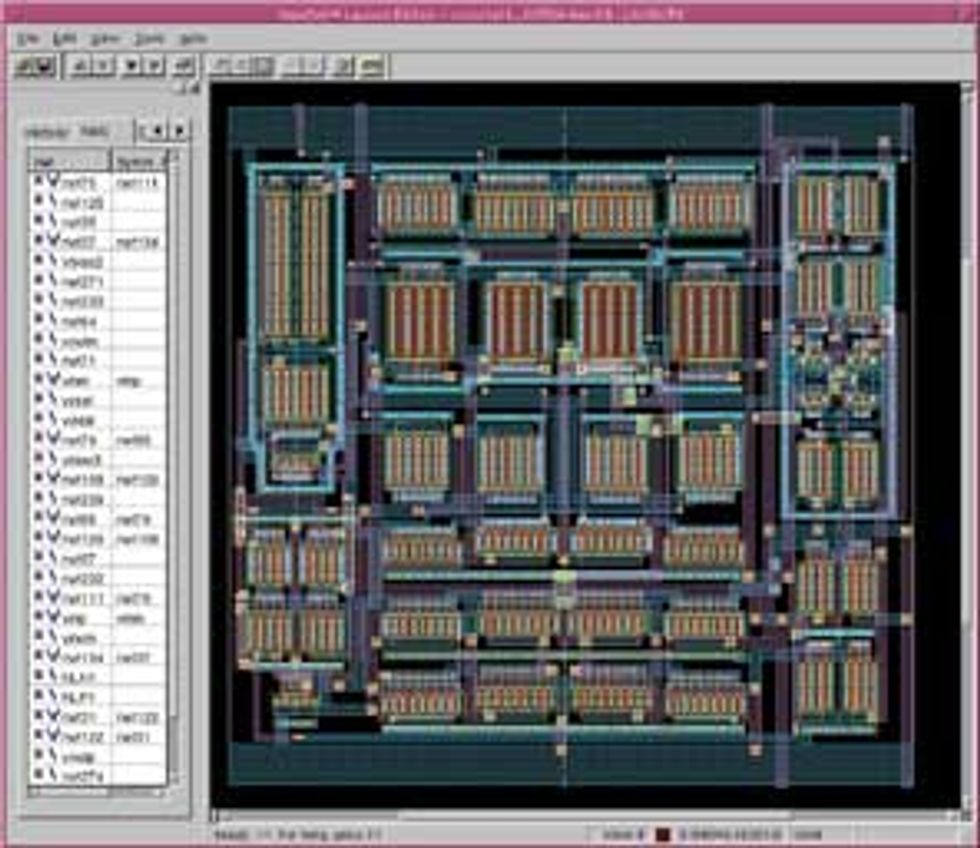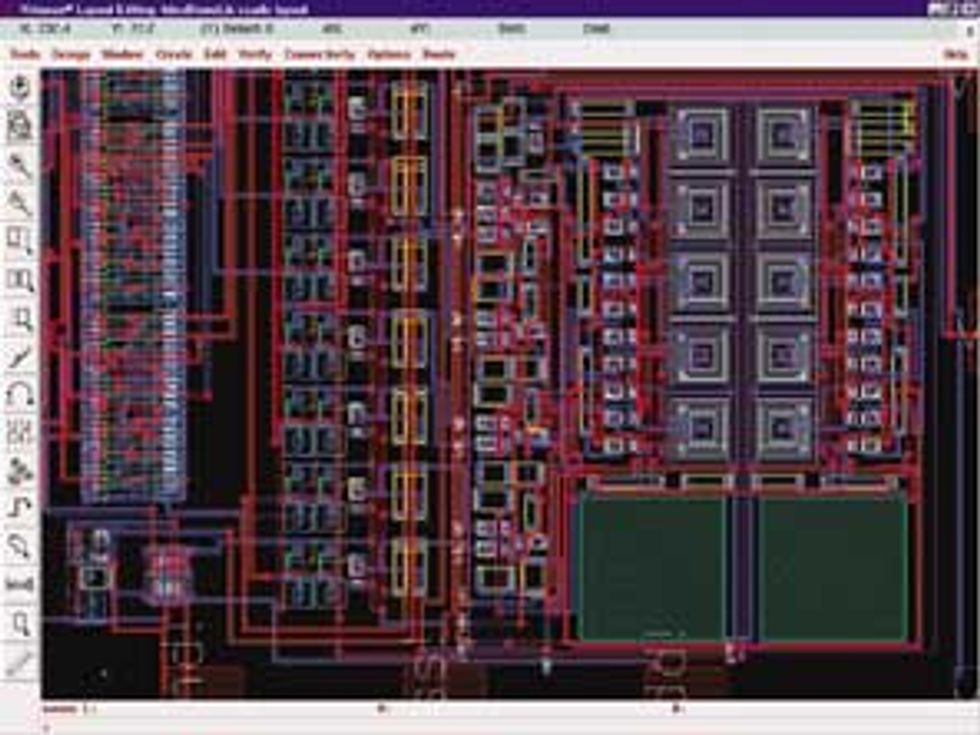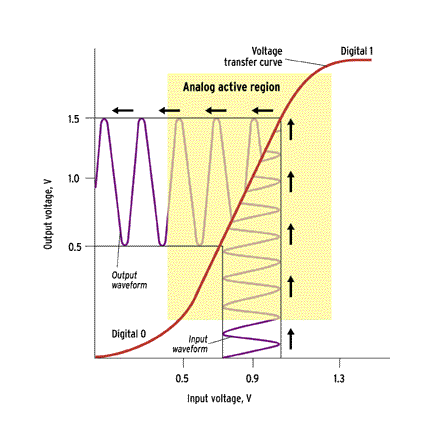Automated placement and routing
Physical layout is the process of turning the symbolic schematic design into a real geometry of transistors, then placing the transistors and routing the wiring between them. While mixed-signal simulation and layout editing tools are established but young technologies, new tools for automating other parts of the analog design process are just emerging–like automatic placement and routing. Rather than manually pushing transistors around on a computer screen, placement and routing would be a pushbutton operation. Given some performance constraints, the tool would find the best solution for arranging and connecting the circuits.
But such technology, long standard for digital design, is unproven for analog. For example, a placement and routing tool from Neolinear is now being evaluated by Philips Semiconductor, Texas Instruments, Raytheon, Sharp, and STMicroelectronics. Dubbed NeoCell, the tool offers the only automated analog placement and routing software available.

Tools like Neolinear’s NeoCell automate the placement and routing of analog circuits. As with many digital designs, the engineers still do some routing manually, but automation shortens design time considerably.
Click on the image for the full illustration view.
Anthony Gadient, Neolinear’s vice president of engineering, told IEEE Spectrum that NeoCell automatically places and routes analog cells at least three times as fast–and with equal or greater performance–than manual placement and routing [see figure].
But Verhoeven’s op-amp group still relies on a layout editor to manually place and route circuits. He said he would not hesitate to use an automatic placement and routing tool if it performed as well as his designers did.
Sharing the synthesis spotlight
In addition to place and route capability, Neolinear also offers a circuit synthesis tool that automatically sizes analog transistors, a critical step in getting a working analog component. The size of an analog transistor determines how it will function with different input voltages. If the transistor is too small, even millivolts of fluctuations can push it out of the active region.
Besides Neolinear, three other companies–Barcelona Design, Analog Design Automation, and Antrim Design–have recently come out with tools billed as analog synthesis. But the companies all seem to have a slightly different interpretation of what, exactly, is meant by that term. None of the offerings resemble the digital approach of hardware-description-language in, netlist out. As long as people are not too picky about the meaning of synthesis, however, analog synthesis is definitely here and working, offering some method of turning high-level specifications for, say, operating voltage and speed into a working component.
Still skeptical of the whole lot is EDA analyst Gary Smith of Dataquest (now part of Gartner Inc., Stamford, Conn.). He has little confidence in these tools because the design methods to support them are not yet in place. Even so, Smith believes that they will be useful for retargeting existing chip designs to new manufacturing processes, which happens every 1218 months.

Software for editing a custom layout [above] is part of a larger analog/mixed-signal design package from Cadence Design Systems. While software can make the job easier, a layout engineer must still “push polygons” to manually place the circuits and draw the electrical connections between them.
Click on the image for the full illustration view.
Barcelona Design’s tool, launched in February 2000, is available only through the Sunnyvale, Calif.based company’s Web site. At the site, the designer is led through the selection of the manufacturing process and circuit topology to the addition of specifications and performance criteria. The tool then creates simulation set-up, netlist, schematic, and placement files that are intended for use with Cadence Design Systems’ analog simulation and custom design tools [see figure].
Taking a different tack is Analog Design Automation Inc., in Ottawa, which is targeting analog companies with its analog synthesis technology based on fuzzy logic algorithms. Amit Gupta, president and CEO, said the company’s technology offers a 2025-fold productivity increase over manual methods and results in higher-quality circuits. It is “Holy Grail technology,” said Gupta, because it addresses the bottlenecks in analog design by enabling less-experienced engineers to produce high-quality analog designs.
Analog synthesis definitely can decrease the time between topology and schematic 10-fold, compared with the traditional manual method, agrees Felicia James, a mixed-signal product development manager at Texas Instruments in Dallas. It can also result in a better-quality circuit. Having all that tedious routine work automated, she said, lets the designers explore tradeoffs and fine-tune the circuit.
At Antrim Design Systems Inc., in Scotts Valley, Calif., the company’s tool set captures specifications and topologies and generates detailed analysis, verification plans, and test suites. Antrim’s strong point is its highly regarded mixed-signal simulator, which is coupled to the synthesis process. Matsushita Electric Industrial Co., Kodoma City, Japan, used Antrim tools to build single-chip DVD players and cell-phone components.
But along with its benefits, automation software for analog requires tradeoffs, not only in circuit performance, but also in the time needed to learn to use the software and fit it into the design flow. Designers will need to use the well-worn approach of considering which parts of the design need to be the “best of the best” and do those by hand. “The rest of the blocks only need to be very good,” Carnegie Mellon’s Rutenbar said, “and tools can do that. You don’t need full custom for everything–you need to get it done in six months,” not in two years.


